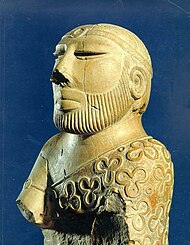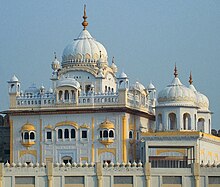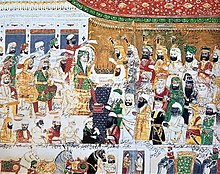Sikh Empire

| History of Pakistan |
|---|
 |
| Timeline |
The Sikh Empire was an empire in the Punjab region of Pakistan, and also covered some areas of India and Tibet.[1] It lasted from 1799, when Maharaja Ranjit Singh captured Lahore, until 1849, when the British East India Company defeated it in the Second Anglo-Sikh War. The empire stretched from Gilgit and Tibet in the north to the deserts of Sindh in the south and from the Khyber Pass in the west to the Sutlej in the east.[2][3]
The empire was divided into four provinces; Lahore, Multan, Peshawar, and Kashmir and had a diverse population of around 4.5 million in 1831, with Muslims being the majority at 70% and Sikhs at 6%.[4] The British Empire annexed it, marking the end of Sikh rule in the Indo-Pak subcontinent.[5]
The empire's origins trace back to the capture of Lahore from Zaman Shah Durrani, and Ranjit Singh became Maharaja in 1801. Expelling Afghans and unifying Sikh misls, he modernized the army with advanced training and weaponry. However, after his death, internal divisions and political mismanagement weakened the empire. The British East India Company took advantage, and in 1849, the Sikh Empire fell after losing the Second Anglo-Sikh War.[6][7]
History[change | change source]

The Sikh Empire officially started in 1801 when the Misls united to form a single state.[8] The leaders of the Misls, linked to the army, were usually from noble families with a long history in Sikh and Muslim traditions.[9]
The empire covered the Punjab region to the west, Khyber Pass, Kashmir in the north, Sindh in the south, and Tibet in the east. In 1799, Ranjit Singh moved the capital from Gujranwala to Lahore, previously established by his grandfather in 1763. Ranjit Singh annexed the Sial State in 1807 after invading Jhang, citing a conspiracy between the local ruler and Nawab Muzaffar Khan of Multan.[10]
Hari Singh Nalwa served as the Commander-in-Chief of the Sikh Khalsa Army from 1825 to 1837.[11] He played a key role in conquering various regions and securing the Koh-i-Noor diamond. Nalwa expanded the empire's frontier to the Indus River, and at the time of his death, the western boundary was the Khyber Pass.[12]
Timeline[change | change source]

- 1699: Formation of the Khalsa by Guru Gobind Singh.
- 1710–1716: Banda Singh defeats the Mughals and declares Khalsa rule.
- 1716–1738: Turbulence, no real ruler; Mughals take back the control for two decades but Sikhs engage in guerrilla warfare.
- 1733–1735: The Khalsa accepts, only to reject, the confederal status given by the Mughals.
- 1748–1757: Invasion of Ahmad Shah Durrani
- 1761–1767: Recapture of Punjab region by Afghans in Third Battle of Panipat.
- 1763–1774: Charat Singh Sukerchakia, Misldar of Sukerchakia misl, establishes himself in Gujranwala.
- 1764–1783: Baba Baghel Singh, Misldar of Singh Krora Misl, imposes taxes on the Mughals.
- 1783: Sikh capture of Delhi and the Red Fort from the Mughals.
- 1773: Ahmad Shah Durrani dies and his son Timur Shah launches several invasions into Punjab.
- 1774–1790: Maha Singh becomes Misldar of the Sukerchakia misl.
- 1790–1801: Ranjit Singh becomes Misldar of the Sukerchakia misl.
- 1799, formation of the Sikh Khalsa Army
- 12 April 1801 (coronation) – 27 June 1839: reign of Maharaja Ranjit Singh.
- March 1809 – August 1809: Nepal–Sikh War.
- 20 February 1810: Siege of Multan (1810).
- 1 June 1813: Ranjit Singh is given the Kohinoor Diamond.
- 13 July 1813: Battle of Attock, the Sikh Empire's first significant victory over the Durrani Empire.
- March – 2 June 1818: Battle of Multan, the 2nd battle in the Afghan–Sikh wars.
- 3 July 1819: Battle of Shopian.
- 14 March 1823: Battle of Nowshera.
- 30 April 1837: Battle of Jamrud.
- 27 June 1839 – 5 November 1840: Reign of Maharaja Kharak Singh.
- 5 November 1840 – 18 January 1841: Chand Kaur is briefly Regent.
- 18 January 1841 – 15 September 1843: Reign of Maharaja Sher Singh.
- May 1841 – August 1842: Sino-Sikh war.
- 15 September 1843 – 31 March 1849: Reign of Maharaja Duleep Singh.
- 1845–1846: First Anglo-Sikh War.
- 1848–1849: Second Anglo-Sikh War.
Administration[change | change source]

The empire was divided into various provinces (known as Subas), them namely being:[13]
| No. | Name | Estimated population (1838) | Major population centre |
|---|---|---|---|
| 1. | Lahore Suba | 1,900,000 | Lahore |
| 2. | Multan Suba | 750,000 | Multan |
| 3. | Peshawar Suba | 550,000 | Peshawar |
| 4. | Derajat Suba | 600,000 | Dera Ghazi Khan, Dera Ismail Khan |
| 5. | Jammu and Hill States Suba | 1,100,000 | Srinagar |
List of rulers[change | change source]
| S. No. | Name | Portrait | Birth and death | Reign | Note | ||||
|---|---|---|---|---|---|---|---|---|---|
| 1 | Maharaja Ranjit Singh | 
|
13 November 1780 (Gujranwala) | 27 June 1839 (Lahore) | 12 April 1801 | 27 June 1839 | 38 years, 76 days | The first Sikh ruler | Stroke |
| 2 | Maharaja Kharak Singh | 
|
22 February 1801 (Lahore) | 5 November 1840 (Lahore) | 27 June 1839 | 8 October 1839 | 103 days | Son of Ranjit Singh | Poisoning |
| 3 | Maharaja Nau Nihal Singh | 
|
11 February 1820 (Lahore) | 6 November 1840 (Lahore) | 8 October 1839 | 6 November 1840 | 1 year, 29 days | Son of Kharak Singh | Assassinated |
| 4 | Maharani Chand Kaur |

|
1802 (Fatehgarh Churian) | 11 June 1842 (Lahore) | 6 November 1840 | 18 January 1841 | 73 days | Wife of Kharak Singh and the only female ruler of Sikh Empire | Abdicated |
| 5 | Maharaja Sher Singh | 
|
4 December 1807 (Batala) | 15 September 1843 (Lahore) | 18 January 1841 | 15 September 1843 | 2 years, 240 days | Son of Ranjit Singh | Assassinated |
| 6 | Maharaja Duleep Singh | 
|
6 September 1838 (Lahore) | 22 October 1893 (Paris) | 15 September 1843 | 29 March 1849 | 5 years, 195 days | Son of Ranjit Singh | Exiled |
| 7 | Maharani Jind Kaur (regent; nominal) |

|
1817 (Gujranwala) | 1 August 1863 (Kensington) | 15 September 1843 | 29 March 1849 | 5 years, 195 days | Wife of Ranjit Singh | Exiled |
References[change | change source]
- ↑ "Ranjit Singh: A Secular Sikh Sovereign | Exotic India Art". www.exoticindiaart.com. Retrieved 2024-01-04.
- ↑ Gupta, Hari Ram (1991). History of the Sikhs. Munshiram Manoharlal. ISBN 978-81-215-0540-6.
- ↑ Singh, Khushwant (2004). History of the Sikhs. Oxford University Press. pp. viii. ISBN 978-0195673081.
- ↑ Dalziel, Nigel; MacKenzie, John M, eds. (2016-01-11). The Encyclopedia of Empire (1 ed.). Wiley. doi:10.1002/9781118455074.wbeoe314. ISBN 978-1-118-44064-3.
- ↑ Melton, J. Gordon (2014-01-15). Faiths Across Time [4 Volumes]: 5,000 Years of Religious History [4 Volumes]. ABC-CLIO. ISBN 978-1-61069-026-3.
- ↑ Fenech, Louis E. (2013-01-31). The Sikh Zafar-namah of Guru Gobind Singh: A Discursive Blade in the Heart of the Mughal Empire. OUP USA. ISBN 978-0-19-993145-3.
- ↑ Khilnani, N. M. (1972). British Power in the Punjab, 1839-1858. Asia Publishing House. ISBN 978-0-210-27187-2.
- ↑ "History of Sikhism". web.archive.org. 2014-05-08. Archived from the original on 2014-05-08. Retrieved 2024-01-04.
{{cite web}}: CS1 maint: bot: original URL status unknown (link) - ↑ Lawrence-Archer, J. H. (James Henry) (1878). Commentaries on the Punjab Campaign, 1848-49. Including some additions to the history of the Second Sikh War, from original sources. University of California Libraries. London : W.H. Allen.
- ↑ Cavendish, Marshall (2006). World and Its Peoples. Marshall Cavendish. ISBN 978-0-7614-7571-2.
- ↑ Fenech, Louis E. (2013-01-31). The Sikh Zafar-namah of Guru Gobind Singh: A Discursive Blade in the Heart of the Mughal Empire. OUP USA. ISBN 978-0-19-993145-3.
- ↑ "Ranjit Singh", 1911 Encyclopædia Britannica, vol. 22, retrieved 2024-01-04
- ↑ Herrli, Hans (1993). The Coins of the Sikhs. p. 10.
